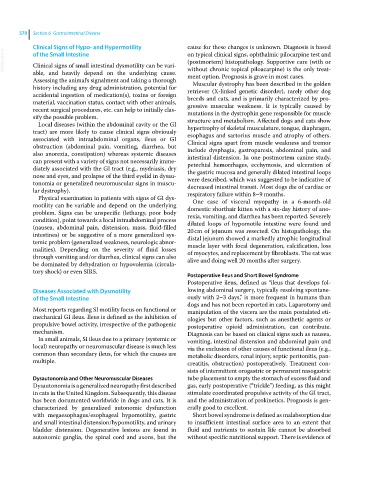Page 602 - Clinical Small Animal Internal Medicine
P. 602
570 Section 6 Gastrointestinal Disease
Clinical Signs of Hypo‐ and Hypermotility cause for these changes is unknown. Diagnosis is based
VetBooks.ir of the Small Intestine on typical clinical signs, ophthalmic pilocarpine test and
(postmortem) histopathology. Supportive care (with or
Clinical signs of small intestinal dysmotility can be vari-
able, and heavily depend on the underlying cause. without chronic topical piloacarpine) is the only treat-
ment option. Prognosis is grave in most cases.
Assessing the animal’s signalment and taking a thorough Muscular dystrophy has been described in the golden
history including any drug administration, potential for retriever (X‐linked genetic disorder), rarely other dog
accidental ingestion of medication(s), toxins or foreign breeds and cats, and is primarily characterized by pro-
material, vaccination status, contact with other animals, gressive muscular weakness. It is typically caused by
recent surgical procedures, etc. can help to initially clas- mutations in the dystrophin gene responsible for muscle
sify the possible problem. structure and metabolism. Affected dogs and cats show
Local diseases (within the abdominal cavity or the GI
tract) are more likely to cause clinical signs obviously hypertrophy of skeletal musculature, tongue, diaphragm,
esophagus and sartorius muscle and atrophy of others.
associated with intraabdominal organs, ileus or GI Clinical signs apart from muscle weakness and tremor
obstruction (abdominal pain, vomiting, diarrhea, but include dysphagia, gastroparesis, abdominal pain, and
also anorexia, constipation) whereas systemic diseases intestinal distension. In one postmortem canine study,
can present with a variety of signs not necessarily imme- petechial hemorrhages, ecchymosis, and ulceration of
diately associated with the GI tract (e.g., mydriasis, dry the gastric mucosa and generally dilated intestinal loops
nose and eyes, and prolapse of the third eyelid in dysau- were described, which was suggested to be indicative of
tonomia or generalized neuromuscular signs in muscu- decreased intestinal transit. Most dogs die of cardiac or
lar dystrophy). respiratory failure within 8–9 months.
Physical examination in patients with signs of GI dys-
One case of visceral myopathy in a 6‐month‐old
motility can be variable and depend on the underlying domestic shorthair kitten with a six‐day history of ano-
problem. Signs can be unspecific (lethargy, poor body rexia, vomiting, and diarrhea has been reported. Severely
condition), point towards a local intraabdominal process dilated loops of hypomotile intestine were found and
(nausea, abdominal pain, distension, mass, fluid‐filled 20 cm of jejunum was resected. On histopathology, the
intestines) or be suggestive of a more generalized sys- distal jejunum showed a markedly atrophic longitudinal
temic problem (generalized weakness, neurologic abnor- muscle layer with focal degeneration, calcification, loss
malities). Depending on the severity of fluid losses of myocytes, and replacement by fibroblasts. The cat was
through vomiting and/or diarrhea, clinical signs can also alive and doing well 20 months after surgery.
be dominated by dehydration or hypovolemia (circula-
tory shock) or even SIRS.
Postoperative Ileus and Short Bowel Syndrome
Postoperative ileus, defined as “ileus that develops fol-
Diseases Associated with Dysmotility lowing abdominal surgery, typically resolving spontane-
of the Small Intestine ously with 2–3 days,” is more frequent in humans than
dogs and has not been reported in cats. Laparotomy and
Most reports regarding SI motility focus on functional or manipulation of the viscera are the main postulated eti-
mechanical GI ileus. Ileus is defined as the inhibition of ologies but other factors, such as anesthetic agents or
propulsive bowel activity, irrespective of the pathogenic postoperative opioid administration, can contribute.
mechanism. Diagnosis can be based on clinical signs such as nausea,
In small animals, SI ileus due to a primary (systemic or vomiting, intestinal distension and abdominal pain and
local) neuropathy or neuromuscular disease is much less via the exclusion of other causes of functional ileus (e.g.,
common than secondary ileus, for which the causes are metabolic disorders, renal injury, septic peritonitis, pan-
multiple. creatitis, obstruction) postoperatively. Treatment con-
sists of intermittent orogastric or permanent nasogastric
Dysautonomia and Other Neuromuscular Diseases tube placement to empty the stomach of excess fluid and
Dysautonomia is a generalized neuropathy first described gas, early postoperative (“trickle”) feeding, as this might
in cats in the United Kingdom. Subsequently, this disease stimulate coordinated propulsive activity of the GI tract,
has been documented worldwide in dogs and cats. It is and the administration of prokinetics. Prognosis is gen-
characterized by generalized autonomic dysfunction erally good to excellent.
with megaesophagus/esophageal hypomotility, gastric Short bowel syndrome is defined as malabsorption due
and small intestinal distension/hypomotility, and urinary to insufficient intestinal surface area to an extent that
bladder distension. Degenerative lesions are found in fluid and nutrients to sustain life cannot be absorbed
autonomic ganglia, the spinal cord and axons, but the without specific nutritional support. There is evidence of

